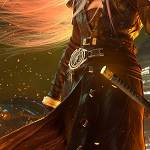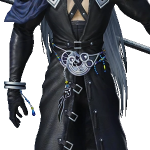He likes Compilation SOLDIER logo, so he used it for Remake OK?
He also likes photorealistic visuals, which OG didn't have and AC did.
Doesn't mean anything. The fact that people are pointing this out to you should be an indication that you're overthinking this.
No, that's not "
overthinking" it at all. And you're actually referring to something entirely different than what my point is.
And saying Nomura just "liked it" is completely irrelevant to the point in the first place. Nomura's tastes in design don't really matter. The actual use, reasoning and context in the media and placement is what matters.
And you can't say you even know how much he 'likes' something, in the first place. Are you Nomura, or connected to him?

They'd include it as a cheerful nod to CC fans, and that's probably all that should be read into it.
So, if I'm understanding you correctly, borrowing any elements from any part of the extended FFVII universe and related games that weren't in the OG contradicts Nomura's claim that there would be no continuity?
No, that's not what I'm saying at all.
First, I asked you, in reference to your hypothetical, what would this can of Banora White
even be doing?
Is it something that actually exists? Do characters see it or interact with it?
And can it be collected, or examined?
If it's something akin to the poster of the cover of FFVII that hangs in Seventh Heaven in Advent Children, no one interacts or acknowledges that poster. That poster exists entirely as an easter egg, a hidden visual that's a tongue-in-cheek reference to something that breaks the fourth wall entirely. Something like that is in essence, independent of the story. It's completely irrelevant and untied to the plot.
If the can of Banora White is just existing somewhere unacknowledged and ignored on the bar, then it
could be something like that, but that would be weird and illogical to assume, since given the context that exists within such a product. It certainly wouldn't break the fourth wall, nor would it be something that is independent of the story, given who's writing this. But, it would be completely ambiguous, undefined, and merely
something that existed in isolation. There would be no context to accurately evaluate something like that.
But, let's say it appeared again and was being consumed by an employee of the Shinra Building. What if a can of Banora White was found on an dusty desk in a corner, with several opened cans of Banora White discarded in a trash can next to it, along with graffiti that said, "I hate this fucking place" and "I'll get revenge one day." What would that mean? Would that just be a cheerful nod? What do you think that would mean?
At what point does a nod become a wink, or even a shout? How do you make that delineation?
Anyways, the references I referred to aren't just things independent of the viewer that break the fourth wall, and why would something as important as design or modeling be somehow
not a form of continuity? Continuity doesn't just mean 'plot' continuity. Continuity exists not just in the plot, but in all aspects as "continuity." Picking and choosing what is and isn't continuity, doesn't really make sense. A connection is a connection. What weight the connection has depends entirely on the context but it still is present
regardless.
Last Order's depiction of the Nibelheim Incident was "canon" in asmuch as the depiction it showed was referenced and utilized in subsequent materials that referenced said incident. Subsequent depictions of that incident, and games that depicted it the way it went down in Last Order, were the game Before Crisis and guide books on FFVII's plot.
It wasn't just "artistic license" or a random change that was done for fun. It was how the writers in that moment referenced the story, until Crisis Core changed the way the Nibelheim Incident was portrayed
again, and made it more akin to FFVII's original depiction.
 Artistic license and all that.
Artistic license and all that. Artistic license and all that.
Artistic license and all that.



